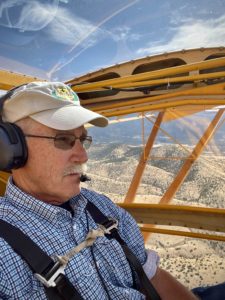Twenty-one years ago this month Gavin Donnelly played a role in post 9-11 evidence processing. Six years before that, in 1995, he helped process the scene in Oklahoma City after the Alfred P. Murrah building bombing. This month, he celebrates his one year anniversary working for New Mexico Tech, where he serves as EMRTC’s Training Operations Manager as well as the sUAS Program Manager.
While beginning a new job during a pandemic may be seen by some as an incredible challenge, Donnelly wasn’t fazed. Perhaps he was well prepared by his varied career background, including working in unpredictable settings through law enforcement. Or maybe it his calm and controlled demeanor, the same traits that make him an experienced pilot and a record-holding competitive pistol shooter. Also possible is that his roles in response efforts to both the Oklahoma City building bombing and 9-11 afford Donnelly a perspective that most of us don’t have. Likely, the combination of Donnelly’s experience and interests is what allows him to very competently lead the division coordinating all of the training for EMRTC as well as manage the sUAS program.

To his role at EMRTC, Donnelly brings extensive experience as a Safety Specialist, having worked within chemical and fabrication industries. Added to that core background in safety is his long history within law enforcement, emergency management, government operations, and bomb disposal and disaster response. His educational background, which includes a B.S. in Administration of Justice and an M.A. in Anthropology from the University of Wyoming, has also allowed him to develop unique qualifications.
Donnelly’s anthropology training provided him with skills in identifying fragments, as most of the human skeletal remains in his lab work during his graduate study were fragmentary. Concentrating on identification of human skeletal remains, Donnelly notes he was able to learn an amazing amount from bones. His studies in biological anthropology, cultural anthropology, and archaeology prepared him to discover and identify artifacts in a defined space and map and catalogue them. That training prepared him for his role processing blast evidence and human remains from 9-11. Donnelly worked at Ground Zero for a day, before spending more than a week at the Fresh Kills landfill, the forensic site for Ground Zero debris. He describes the experience as both tragic and fascinating, noting the mental and physical tolls law enforcement and fire personnel faced. While he acknowledges this work was intense for him, he attributes his tendency to move forward as one that helped him avoid carrying a huge load of PTSD.
His involvement in 9-11 post blast scene processing was not Donnelly’s first experience of this type. In April of 1995, shortly after graduating from college, Donnelly had just returned home to Wyoming after hiking the Grand Canyon when the Alfred P. Murrah building in Oklahoma City was bombed. With his bomb technician experience and professional connections to several who were in Oklahoma City, he recognized they could use extra help in response efforts. He went to the site for a week, sifting and processing the scene. While there, he learned quite a bit. While some of the images and smells of decay from that experience have never left him, he focused on describing how fascinated he was by the extent of the damage. While of course the building was heavily damaged, in addition, the effects of the blast on nearby buildings was truly amazing. Donnelly learned plenty seeing firsthand the effect of blast pressure waves and their movement through the surrounding environment.
In the role that brought him to EMRTC, Training Operations Manager, Donnelly leads the division coordinating all of the training courses, scheduling logistics, and travel. His background as a pilot made taking on the sUAS Program Manager role a natural fit. Within the last year, he has earned his own commercial drone operator’s license. The sUAS program has expanded from one pilot to three, and according to Donnelly, “These new pilots are drinking from fire hoses but doing extremely well and coming up to speed fast.” He describes the sUAS program and the pilots he works with as excellent, noting that despite the challenges of coming up to speed on a new program, the eagerness and dedication of his coworkers makes his job easier.
While he leaves the sUAS instructing to the three dedicated full-time pilots in that program, Donnelly has experience playing an instructional role for the IRTB course. Having a foot in instruction helps keep him connected to the content and students. He notes “you don’t truly learn your craft until you teach it.” The educational setting is one of the aspects of his work that Donnelly most enjoys. He appreciates being in an environment so much research and development is happening and where every day is different.
Donnelly’s professional and personal interests certainly overlap. When he’s off the clock, he enjoys piloting his small aircraft into the back country. In his words, he’s got a “bad welding habit,” and he has taken machine tools courses and has even used his lathe to make drop mechanisms for drones. In addition, it’s an understatement to describe Donnelly as holding his own in high master class pistol competitions. He has earned a perfect score in Police Combat Shooting Competition, joining others who’ve achieved this feat to hold a national record.
